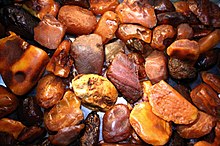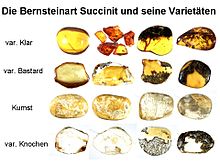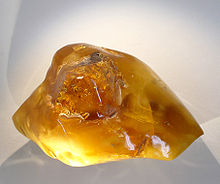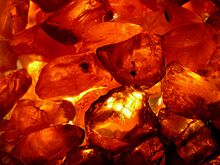Amber
![]()
This article is about fossil resin. For other meanings, see Amber (disambiguation).
Amber is a clear to opaque yellow gemstone made of fossil resin that has been known for thousands of years and is particularly widespread in the Baltic Sea region.
This predominantly refers only to a certain fossil resin, this amber in the narrower sense is the amber species with the scientific name succinite. The terms succinite and Baltic amber are often used synonymously, since succinite makes up the vast majority of Baltic amber. The other fossil resins in Baltic Amber come from different plant species and are also referred to as "amber in the broader sense". Some occur together with the succinite, e.g. the amber species Gedanite, Glessite, Beckerite and Stantienite, which have been known for a long time from the Baltic deposits. These are also called accessory resins. Other fossil resins of different botanical origin, however, form independent deposits of different geological ages, such as Dominican amber and Lebanon amber. Of the large group of copals, only the fossil representatives dug out of the earth (e.g. the "Madagascar copal") belong to the ambers according to the definition (see section on amber types) despite their geologically young age.
This paper deals with the subject of amber in general and, because of its outstanding scientific, cultural and economic importance, with the most common Baltic amber species, succinite, in particular.
The oldest known amber comes from coals that are about 310 million years old. Since the Paleozoic era, the resin of trees of that time has been preserved as a solid, amorphous (non-crystalline) substance.
Amber is not recognized by the International Mineralogical Association (IMA) as an independent mineral species due to its not clearly definable composition. However, it forms in the systematics of minerals within the class of organic compounds a mineral group of its own, which can be found in the 9th edition of the systematics according to Strunz under the system no. 10.C (Miscellaneous organic minerals) (8th edition: IX/C.01).
Already since prehistoric times amber has been used as jewellery and for art objects. Some objects found in Egypt, for example, are more than 6000 years old. The most famous art object made of amber was the Amber Room, which has been lost since the Second World War. Between 1979 and 2003, Russian specialists reconstructed the Amber Room in the Catherine Palace near Pushkin, which was once again open to the public, in great detail using amber from Jantarny, after previously unknown photographs were found that made this unique project possible.
For science, especially for paleontology, amber with inclusions, the so-called inclusions, is of interest. These inclusions are fossils of small animals or plant parts whose imprints, in rare cases also tissue remains, have been perfectly preserved in amber for millions of years.
Amber species and varieties, natural forms and cultivars.
General definitions
In the recent plant world, especially in the tropics and subtropics, hundreds of plant species are known to secrete resin. From some, often now extinct species, the resin has been preserved fossil. In scientific parlance, the name amber has long been used as a collective term for all fossil resins that form solid particles. For the fossil resin originating from a specific plant species, the term amber species has become common. Although ambers are not minerals, the suffix -it is used in reference to the frequent naming of minerals for amber species. Already since 1820 the most common Baltic amber species, the amber in the narrower sense, bears the name succinite. Common is also the connection with names of regions or places, e.g. "Baltic Amber", "Dominican Amber", "Bitterfeld Amber". Originally, these names were only used to designate general amber localities or collectives of amber species.
In the Baltic amber deposit other types of amber are very rare, so that for the dominant amber type succinite the name amber is colloquially used, in former times also the term "German amber" was common. The frequently used name "Baltic amber" for succinite is scientifically not tenable because of the numerous finds in Central Germany that became known some time ago and should not be used to avoid mistakes. Because also in the world's second largest amber deposit Bitterfeld the succinite is the most common type of amber and a resulting name "Baltic amber from Bitterfeld" would lead to misunderstandings. For the amber species succinite the name amber (succinite) is best suited to link the colloquial with the scientific name. Since other types of amber also occur in both deposits, the name "Baltic amber" would have to be restricted to the regional origin. Similarly, "Ukrainian amber" (also "Rovno amber") is a collective of amber species, and this term should also be applied only to indicate the regional occurrence.
Amber species, like minerals, are distinguished varieties according to their color, transparency and other characteristics. They are substantially identical and come from the same producer plant.
Natural forms can be distinguished according to their external appearance: Their shape is due to the direct separation of the resin and the change in shape during transport from the producer tree to the deposit.
For identification purposes in the technical extraction and processing of succinite, a distinction is made between varieties and commercial grades.
Amber species
More than 80 types of amber are known worldwide, but most of them occur only in small quantities. A selection can be found in the article amber occurrences. The most common type of amber is succinite, according to one estimate there are still more than 640,000 tons in the Baltic States alone. From the Baltic deposits the accessory amber species gedanite, glessite, beckerite and stantienite have been known since the 19th century.
About the accessory fossil resins found in the waste (brack) during the amber extraction in Bitterfeld there were long lasting and also contrary discussions, e. g. In the meantime the errors caused by the great rarity have been revised. In the Bitterfeld amber deposit, besides the 99.9 % dominating succinite, the amber species gedanite, glessite, beckerite, stantienite, goitschite, bitterfeldite, durglessite and pseudostantienite as well as further eleven fossil resins not yet identified by name occur.
Copals, unless recent resin collected from trees is also included, are young fossil resins of the tropics and subtropics of West and East Africa, Madagascar, the Malay Archipelago, New Zealand and Colombia. They are also considered by some authors to be amber species despite their young age. Their lower hardness and greater solubility compared to older amber species are not, as is often assumed, a consequence of "immaturity", but, as with the similarly soft older amber species goitschite and bitterfeldite from Bitterfeld, a property of the parent resin.
Amber varieties
Of the amber species succinite, varieties are distinguished in particular according to the degree of turbidity, characteristic are the flowing transitions and mixtures in the individual pieces:
- Clear or sheer clear, completely transparent like glass, colouring very faint light yellow (ice clear) to brownish yellow (Brunswick clear).
- Flom or Matt, semi-transparent cloudy due to microscopic bubbles.
- Bastard, completely opaque rich cloudy, homogeneous to cloudy or spotted (so-called Kumst after the East Prussian name for sauerkraut) with varying degrees of colouring.
- Bone, completely opaque ivory to pure white (white resin).
- Foam, completely opaque yellowish white, lighter than fresh water (weathering form of the variety bone).
- Black varnish, grey-black to marbled, wood mulch and soil with resin as binder.
- Variegated, mixture of varieties Clear to bone, often sharply demarcated and with clefts (see Origin section).
- Antique, varieties Clear to bastard colored by weathering to varying degrees of red to reddish brown.
Varieties of rarer amber species, e.g. glessite and bitterfeldite, are also known.
Nature Forms
Among the natural forms, the primary ones must be distinguished from the secondary ones. The primary natural forms were formed during the outflow of the resin, they are therefore often called river forms:
- Dandruff was formed when the resin came out in batches and covered the preceding resin outflows in a more areal manner. They are mostly clear, dirt (e.g. dust) is not uncommon on the separating surfaces, they contain most fossil inclusions (inclusions).
- Cones formed from more punctate resin flows that solidified on their own droplet thread before falling. Prolonged resin flows can result in thicker resin stalactites. They also contain fossil inclusions.
- Drops formed from dripped resin, predominantly flattened and discus-shaped, but also spherical to pear-shaped.
- Tile (slabs) formed by resin accumulation of the varieties bastard and bone behind the bark or in crevices, without inclusions.
- Tubers are lumpy resin accumulations in secondary cavities of the wood body (e.g. due to pest infestation or wind breakage), predominantly variety bastard, without inclusions.
Secondary natural forms were created by weathering processes and the stresses of transport from the place of origin to the deposit:
- Earthstone is the most common form in the deposits, the typical weathering crust formed by prolonged storage in air before final bedding.
- Sea stone is the typical form of the pieces washed up on the coasts of the Baltic and North Seas and looks as if it has been polished, the weathering bark has been worn away by grinding over sand.
- Boulders occur especially with softer amber types, the well rounded pieces indicate a longer transport route.
Varieties and commercial varieties
The industrially extracted amber (succinite) is sold in particular sorted according to size and varieties. Amber that is not suitable for jewellery production, but at best for amber distillation, or that is contaminated or too fine-grained, is referred to as brackish, slag or varnish.
Raw amber usually still bears a weathering crust, provided this has not been worn away by prolonged drifting on the seabed. This and cut and polished amber, whose inner structure or color has not been artificially altered, are called natural amber.
Commercially available amber jewelry often contains clear boiled amber. This is originally cloudy, unsightly natural amber which has been boiled in hot oil. Oil has a much higher boiling point than water, so temperatures are reached at which the fossil resin becomes soft and more permeable and the tiny air bubbles are filled with oil. The light refraction factor of oil is almost identical to that of amber, so the bubbles are no longer visible after the amber has cooled. The result is a crystal clear, uniformly colored "stone". However, the process has a flaw: amber treated in this way is very sensitive during the cooling process. If the material is not cooled down carefully degree by degree, so-called "sunflints" develop in it, more or less semicircular, golden shining cracks. These are to be found in untreated amber only very rarely and at most at break places. Sometimes, however, the cooling process is deliberately controlled in such a way that decorative and attractive flints are formed. For clarification, instead of "clear boiling" in oil, the amber can also be heated in a sand bath. In this process, the bubbles fill with a resinous mass supplied by the amber itself. Clarified amber is no longer a pure natural product.
Pressed amber is offered in the trade misleadingly as real amber, real amber or Ambroid. However, this does not mean the naturally formed amber, but a product that was made from grinding residues and small pieces in an autoclave. Pressed amber is produced by heating purified amber crumbs and then pressing them together under strong pressure. This is done in the absence of air and at a temperature of 200 °C to 250 °C. The pressure is up to 3000 bar. At a pressure of up to 3000 bar, the mass is solidified into rod- or bow-shaped bodies. By varying the heat and pressure, different shades of colour and both clear and cloudy pressed amber can be produced.
In addition to these forms of amber, genuine amber is offered separately in the trade, a pressed amber which, apart from its irregular flashes, can hardly be distinguished visually from natural amber due to its low and fine-grained streak distribution. It can only be clearly determined by gemmological examination methods.

Raw amber with weathering crust

Varieties of succinite from the Bitterfeld deposit
Properties
The color of amber (succinite) ranges from colorless to white, light to golden yellow and orange to shades of red and brown; in cloudy pieces, greenish and bluish tones can rarely occur due to light refraction effects. Dark brown to black-grey pieces contain larger quantities of vegetable and mineral inclusions. The degree of turbidity depends on the number of microscopic bubbles it contains. The variety bone (white resin) has the highest vesicle density (size: 0.0002 mm to 0.0008 mm, number: up to 900,000 per mm2). The view that the vesicles are "filled with water and terpenic oil", i.e. that the cell sap of the amber trees has been preserved, is outdated. In the mountain-fresh condition the bubbles are filled with water. Since amber is not gas-tight, the water evaporates more or less fast in the air. With larger cavities a spirit level can develop in the meantime like with a spirit level.
With other types of amber the play of colors is much larger, e.g. deep black (stantienite, pseudostantienite), dark blue-grey (glessite) and also blood-red colors. The blue shimmer, which often occurs in Dominican amber, is well known.
Unlike imitations made of synthetic resin, amber (succinite) can be easily ignited and shows a yellow, strongly sooty flame during burning. It smells resinous and aromatic and turns into a black, brittle hardening mass. The resinous smell arises because volatile components (essential oils) of the amber burn. This is why it is suitable for incense and has been used as an incense in many cultures for centuries. For example, in India it serves as a substitute for incense for sacred purposes or is used in the traditional rituals of Sufism.
Physical properties
Amber (succinite) has a Mohs hardness of 2 to 2.5, making it a fairly soft material. It is possible to carve a furrow in the surface with a copper coin. Some other types of amber are much softer (e.g. goitschite, bitterfeldite, copal) or much harder, e.g. the brown resins, which can hardly be scratched with a steel needle. Others have a rubbery consistency (e.g. pseudostantienite) or are extraordinarily tough (e.g. beckerite).
Ambers are only slightly denser than water. Because of their low density (around 1.07 gcm-3) they float in saturated salt solutions. This property was used in amber extraction in Bitterfeld to separate the amber from foreign components in the sieve residue >3 mm.
Amber (succinite) has no melting point, at 170 °C to 200 °C it becomes soft and malleable, and above 300 °C it begins to decompose. Dry distillation, which used to be carried out on a large scale, produces amber oil and amber rosin as its main products. Amber oil was used for flotation of ore in the first half of the 20th century, and the rosin was a sought-after raw material for lacquer. Both substances have essentially lost their economic importance and are now only niche products, amber oil, for example, as a natural remedy.
Amber (succinite) has a very high electricalresistance and a very low dielectric constant of 2.9 as natural amber or 2.74 as pressed amber. In a dry environment it can be electrostatically charged by rubbing against textile fabric (cotton, silk) or wool. In the process, it acquires a negative charge, i.e. it takes up electrons. The friction material receives a positive charge by releasing electrons. This charge is also called frictional electricity. This property can be used as a non-destructive, although - especially with smaller pieces - not always easy to perform authenticity test: The charged amber attracts small pieces of paper, fabric fibers or wool lint. This effect was already known in antiquity and was handed down to the late Middle Ages through the works of Pliny the Elder. The English naturalist William Gilbert devoted a separate chapter to it in his work De magnete magneticisque corporibus, published in 1600, and distinguished it from magnetism. Gilbert also coined the term "electricity", which he derived from the Greek word ἤλεκτρον ēlektron for amber.
Amber (succinite) glows blue under UV irradiation (wavelength 320 to 380 nm) when unweathered or freshly polished and a dull olive green when weathered. Succinite is lustrous when moist or polished, as it exhibits high light refraction when smooth. It allows X-rays to pass through it with almost no loss in layers up to 10 mm thick.
A classification according to their physical properties has been presented by Fuhrmann & Borsdorf, besides a succinite group (succinite, gedanite) a glessite group (glessite, bitterfeldite, durglessite, goitschite), a beckerite group (beckerite, siegburgite) and a stantienite group (stantienite, pseudostantienite) are distinguished. Very easy to perform infrared spectrometric investigations support this classification, the most common amber species succinite, for example, is characterized by a distinctive section in the IR spectrogram, the so-called "Baltic shoulder".
Chemical properties
Deciphering the chemical properties of the amber species succinite has a long history. For example, the distillation product succinic oil was already known in the 12th century; Agricola extracted succinic acid in 1546, and the Russian polymath V. Lomonosov succeeded in the mid-18th century in providing scientific proof of the nature of amber as a fossil tree resin. Berzelius found out in 1829 with already modern seeming chemical analysis methods that amber is composed of soluble and insoluble components.
According to elemental analysis, amber consists of 67-81% carbon, the rest is hydrogen and oxygen, and sometimes some sulfur (up to 1%). Other elements may be present due to the incorporation of mineral components. Amber is a mixture of various organic substances bound in long thread molecules. Proven soluble components are e.g. abietic acid, isopimaric acid, agathendic acid as well as sandaracopimaric acid. The insoluble constituent of amber is an ester called succinin (or resene, sucinoresen→succinate). To date, over 70 organic compounds have been shown to be involved in the formation of succinite.
Most types of amber weather through exposure to atmospheric oxygen and UV radiation. In the case of succinite, the outer layers darken first and turn red (antique variety). Starting from the surface and existing cavities, small polygonal cracks form, with time the surface becomes rough and crumbly, and finally the entire piece is decomposed. This also destroys existing inclusions.
Many types of amber are only slightly soluble in organic solvents. Amber (succinite) reacts only on the surface with ether, acetone and sulfuric acid; with longer exposure it becomes dull. Pressed amber is less resistant. On prolonged contact with the above substances it becomes doughy and soft. The same applies in principle to copal and synthetic resin, except that with these, much shorter contact is sufficient.
The nomenclature of fossil resins is confusing. The designation of amber species both with regional names according to countries and regions and according to their properties in analogy to minerals with the suffix -it can lead to misunderstandings (see section Amber species).
In a first outdated attempt to distinguish on the basis of chemical composition, succinites with 3% to 8% succinic acid were separated from retinites with up to 3% succinic acid.
In 1995 Anderson & Crelling established the following classification according to the basic chemical building blocks: (translation closely based on Christoph Lühr)
- Class I: Polymers of labdanoid diterpenes and carboxylic acids, alcohols and hydrocarbons. (Amber types with a labdane skeleton show a relationship with resins of the family Araucariaceae). Class I is divided into three subclasses. Fossil resins of this class are the most widespread.
· Class Ia: polymers and co-polymers of labdanoid diterpenes, such as communic acid, communol and significant amounts of succinic acid (which includes succinite and glessite).
· Class Ib: Polymers and co-polymers of labdanoid diterpenes, such as communic acid, communol and biforms. Succinic acid is not included (this includes fossil resin of kauri spruce).
· Class Ic: polymers and copolymers of labdanoid diterpenes in enantiomeric configuration, e.g. ozoic acid, ozole and biforms (including resins of the extinct tree species Hymenaea protera, Mexican and Dominican amber).
- Class II: Macromolecular structures based on bicyclic sesquiterpenoids (especially with cadinane framework). (This includes amber from various deposits in Utah/USA and Indonesia).
- Class III: Natural fossil polystyrene (including siegburgite, beckerite and New Jersey amber).
- Class IV: Non-polymeric structure, generally containing sesquiterpenes with a cedrane skeleton (this includes, for example, retinites of European lignite deposits).
- Class V: Non-polymeric diterpenoid resin acids, based in particular on abietane, pimarene and iso-pimarene (including, for example, fossil resins of the genus Pinus).
The classification of unknown amber species requires very complex mass spectrometric, gas chromatographic or nuclear magnetic resonance spectroscopic investigations.
The determination of the botanical origin on the basis of the chemical composition is problematic, because the low solubility of the high-polymer compounds causes extreme analytical difficulties, because the fragments resulting from the forced pyrolytic splitting are usually not identical with the original substances. The botanical origin of a fossil resin can only be determined with certainty by palaeobotanical investigations, as is the case with Gedanite.

Amber (approx. 12 cm Ø)

Natural amber light
Questions and Answers
Q: What is amber?
A: Amber is fossil resin that occurs in different colors and is widely used for making jewelry and other ornaments.
Q: Is amber a mineral?
A: No, amber is not mineralized but is sometimes considered a gemstone.
Q: How old is most of the world's amber?
A: Most of the world's amber is in the range of 30–90 million years old.
Q: What is semi-fossilized resin or sub-fossil amber called?
A: Semi-fossilized resin or sub-fossil amber is called copal.
Q: What was Baltic amber called by the Norse and the ancient Greeks?
A: Baltic amber was called 'Freya's tears' by the Norse and the 'tears of the Heliades' by the ancient Greeks.
Q: What does amber consist of?
A: Amber consists of several resinous bodies that can mostly dissolve in alcohol, ether, and chloroform, associated with a bituminous substance that does not dissolve.
Q: What is the use of amber?
A: Amber is widely used for making jewelry and other ornaments.
Search within the encyclopedia